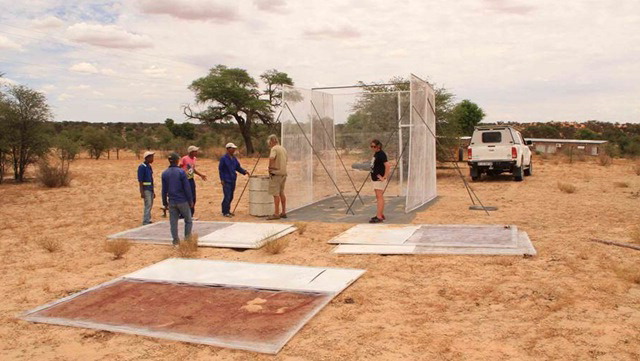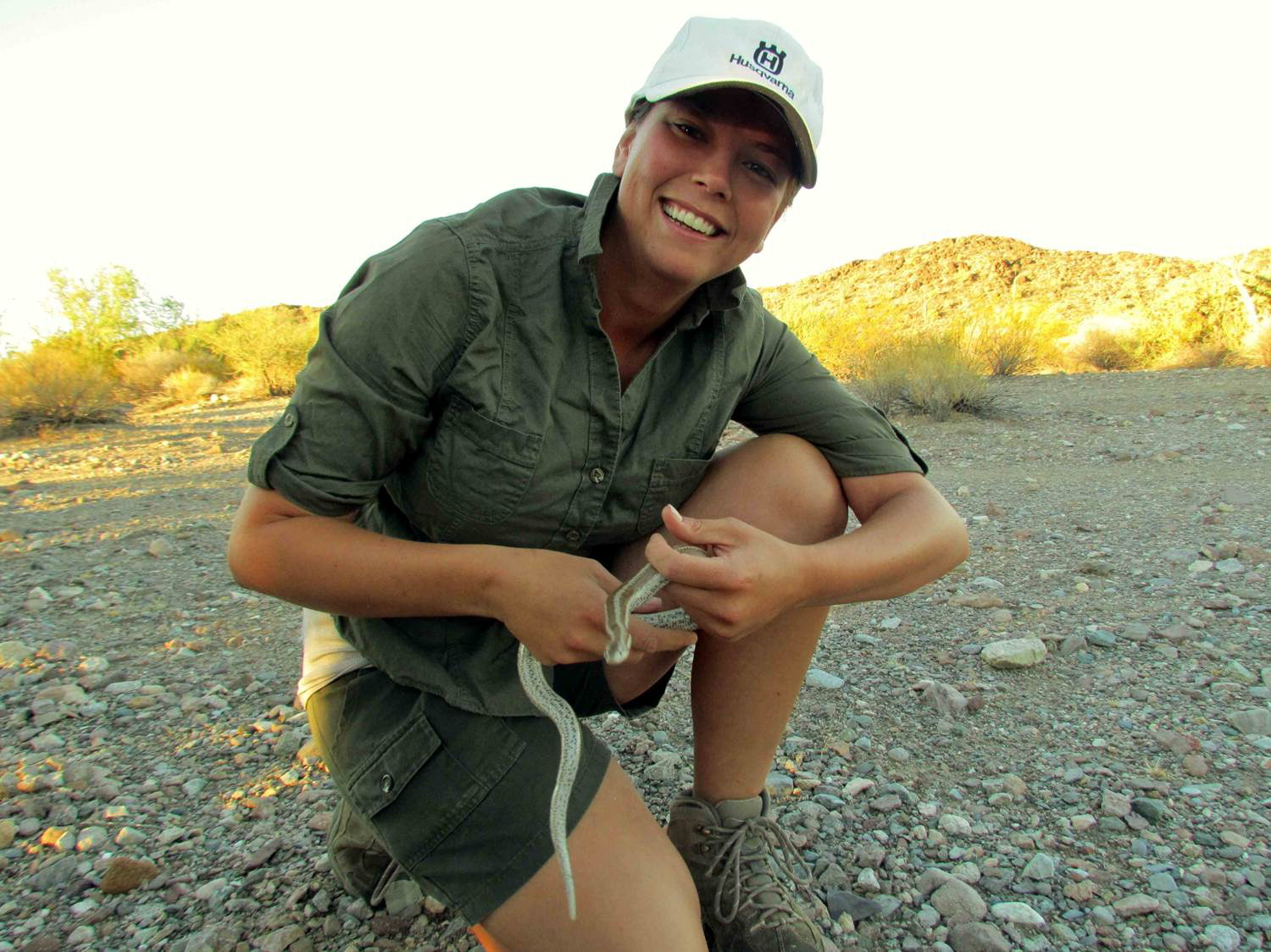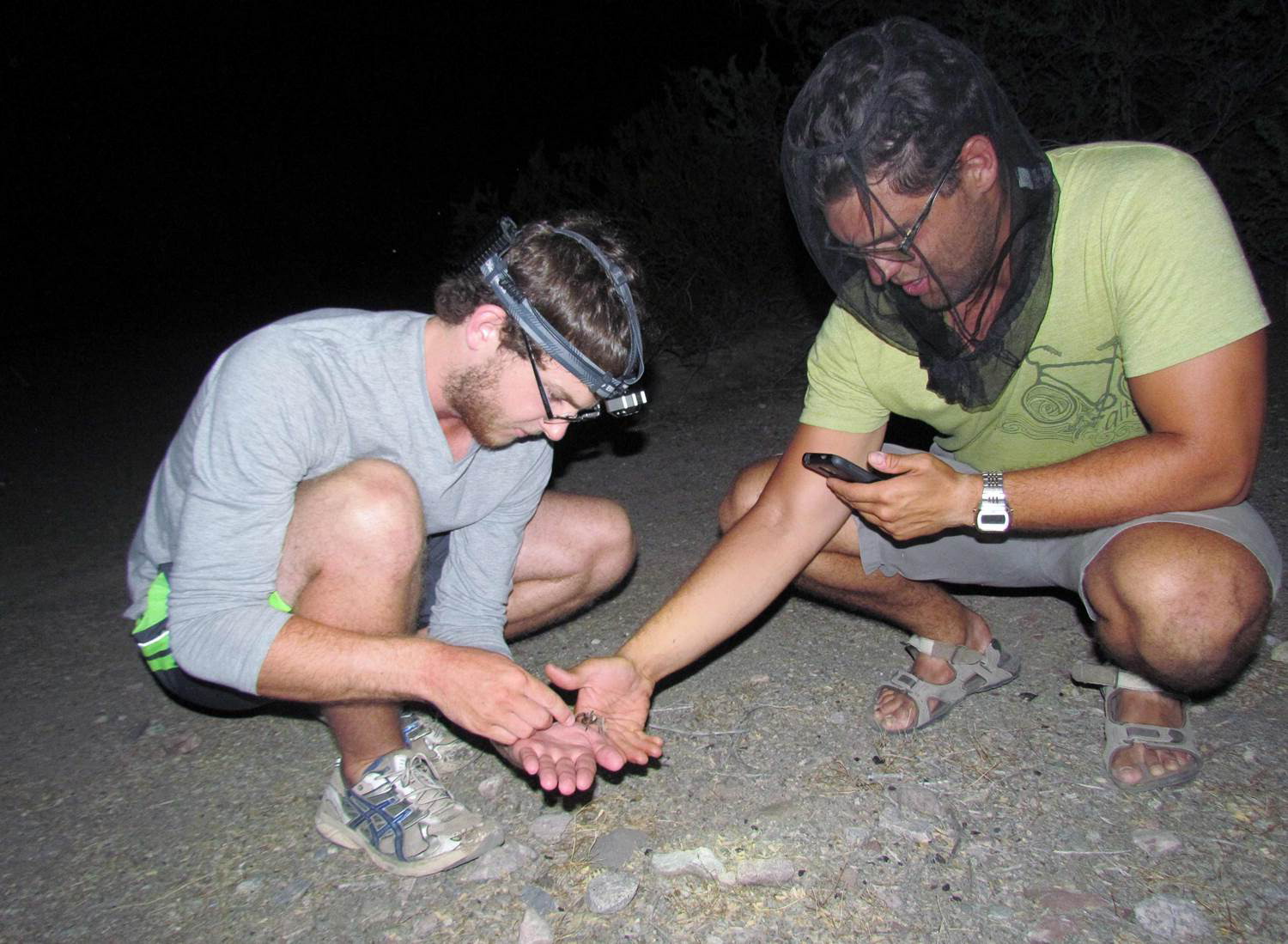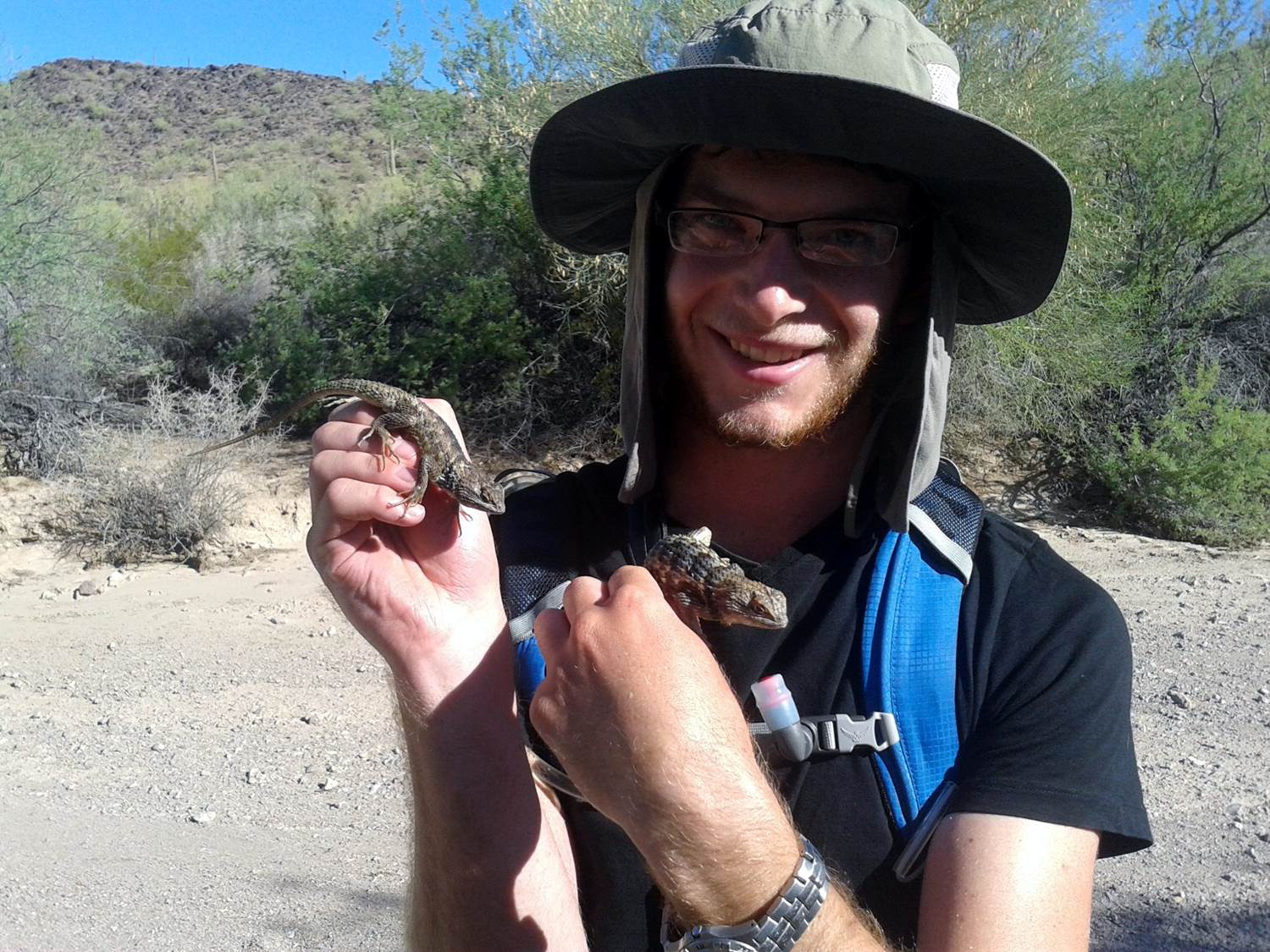|
|
Cycle 2 (2012 Deadline)
Climate change and arid-zone birds: validation of a behavioral index for assessing species’ relative vulnerabilities to rising temperatures PI: Andrew McKechnie (University of Pretoria) U.S. Partner: Blair Wolf (University of New Mexico)
Project Dates: August 2013 to March 2016  | | An aviary under assembly at Murray Game Ranch, an 11,000–hectare property outside the town of Askham in the Northern Cape province of South Africa. Photo courtesy: Dr. McKechnie. |
Predicting the impacts of climate change on birds is one of the greatest challenges currently facing ornithologists. A priori, bird communities inhabiting hot desert environments may be expected to be among the vulnerable to rising temperatures, on account of the thermal stresses and unpredictable water and food resources encountered in these habitats. Increasing temperatures in hot deserts are predicted to cause bird range changes, but at present we have no capacity to predict which species will respond first or when the response will occur. Making such predictions requires a mechanistic understanding of the links between the physical/environmental characteristics of habitats and organismal performance. The physiological research needed to elucidate these links requires time-consuming and intensive study of individual species, making this approach generally unsuitable for anything more than a small subset of the species that make up arid-zone bird communities. The research to be carried out as part of this PEER Science project seeks to validate a behavioral index of vulnerability to heat stress in birds inhabiting hot desert environments. Dr. McKechnie and his team will test predictions that relate heat dissipation behaviors to underlying changes in body temperature and hydration status in model species that vary in terms of the relationship between environmental temperature and heat dissipation behaviors. The over-arching aim of this research is essentially to develop a rapid assessment tool, whereby the relative vulnerabilities of birds making up arid-zone communities to more frequent and severe heat waves can be assessed largely on the basis of behavioral observations. The development of such a rapid assessment tool will mean that the species most vulnerable to the impacts of climate change can be identified in any desert environment, anywhere in the world, on the basis of readily collectable behavioral data. This project is directly relevant to USAID’s Environment and Global Climate Change focus area. It relates to aspects of the Global Climate Change component (helping conservationists and other environmental stake-holders “prepare for and respond to changes in climate”) as well as the Conserving Biodiversity component. Birds provide a host of vital ecosystem services, including pollination, seed dispersal, and insect pest control, and the identification of those avian taxa most vulnerable to rising temperatures has far-reaching implications for predicting how climate change will affect arid-zone ecosystems and the human communities that depend on them. This project is focused on a global scale, and although the researchers will work in one specific desert (the Kalahari of southern Africa), the outcomes of this research will be applicable globally. This project will also provide opportunities to train several students, with an emphasis on recruiting students from historically disadvantaged sectors of the South African population. Moreover, this research will strengthen links between South African institutions and their U.S. counterparts and will pave the way for future collaborative research in related fields. Even though this study will focus on birds inhabiting desert habitats, the researchers are using desert systems as a “proving ground” for a conceptual framework that should be able to predict climate change impacts among birds inhabiting other biomes, including tropical forests. Final Summary of Project Activities In the final year, the graduate team member spent three months at their field site near Askham in the Kalahari Desert. During this time, she obtained behavioral and body temperature data for two species: Namaqua Dove and White-backed Mousebird, using the same approaches as during the first and second field seasons. The data collected consisted of body temperatures using VHF temperature-sensitive transmitters, behavioral observations to quantify the temperature-dependence of heat dissipation behavior, and experimental manipulations of hydration status to test hypotheses concerning the interacting effects of hydration status and thermoregulation. Behavioral analyses and body temperature data collected revealed several key findings. One major question for the project was establishing whether HD50 values vary between captive and free-ranging birds. The data suggests that, for all but Cape Turtle-Doves, HD50 is either slightly higher or slightly lower under captive conditions. Omnivorous species tend to have lower HD50 in captivity whilst granivores and frugivores have higher HD50 in captivity. Of the four species examined, no changes in heat dissipation behavior with water restriction were observed for the two frugivorous species. For these two species, HD50 on water restricted (WR) days was almost identical to ad libitum (AL) HD50, where water was freely available. There remains more than 10 °C variation in captive HD50 values, providing the interspecific variation necessary to test hypotheses concerning the physiological basis of these behavioral differences. Frequency distributions of daytime body temperatures for eight species reveal relatively high body temperatures, with modal values between 41 and 43 C for all species investigated. As expected, the three columbids (i.e., doves and pigeons) appear to show slightly lower values compared to passerines. Preliminary data of body temperature for the water restriction experiments do not reveal any obvious differences in patterns of thermoregulation on hot days between conditions of ad libitum water availability (AL) and water restriction (WR). There appear to be no major shifts in modal body temperature with water restriction for any species tested. There are interesting interaction effects between air temperature and water restriction, suggesting that on only on water restricted days body temperature increases with increases in air temperature. In summary, the team collected data for nine species, which was the total envisaged in the original proposal. The PhD student is in the process of analyzing this very large data set (the number of body temperature data, for instance, runs into many thousand for each species).  |  |  | | Michelle and Nicholas discovering various Arizona desert species during their behavioral data collection fieldwork in Arizona, July 2014. Photo courtesy: Dr. McKechnie. |
PublicationsMcKechnie, A.E. 2016. Burchell’s Sandgrouse: not so chilled? African Birdlife May/June 2016: 15. McKechnie, A.E. 2016. Mercury rising - South Africa’s national parks are getting warmer. African Birdlife March/April 2016: 14. McKechnie, A.E., Whitfield, M.C., Smit, B., Gerson, A.R., Smith, E.K., Talbot, W.A., McWhorter, T.J. and Wolf, B.O. (in press). Avian thermoregulation in the heat: efficient evaporative cooling allows for extreme heat tolerance in four southern Hemisphere columbids. Journal of Experimental Biology. https://doi.org/10.1242/jeb.138776McKechnie, A.E., Smit, B., Whitfield, M.C., Noakes, M.J., Talbot, W.A., Garcia, M., Gerson, A.R. and Wolf, B.O. Avian thermoregulation in the heat: evaporative cooling capacity in an archetypal desert specialist, Burchell’s sandgrouse (Pterocles burchelli). Journal of Experimental Biology. https://doi.org/10.1242/jeb.139733Noakes, M.J., Wolf, B.O. and McKechnie, A.E. 2016. Seasonal and geographical variation in heat tolerance and evaporative cooling capacity in a passerine bird. Journal of Experimental Biology 219: 859-869. https://doi.org/10.1242/jeb.132001Whitfield, M.C., Smit, B., McKechnie, A.E. and Wolf, B.O. 2015. Avian thermoregulation in the heat: scaling of heat tolerance and evaporative cooling capacity in three southern African arid-zone passerines. Journal of Experimental Biology 218: 1705-1714. https://doi.org/10.1242/jeb.121749 Back to PEER Cycle 2 Grant Recipients
|
|
|
|







